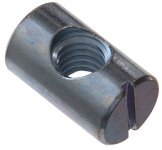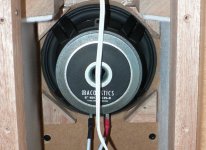I am modifying a speaker cabinet and need to have removable panels. The panels are Valchromat (a bit denser/stronger than MDF) and are 19mm or 12mm and some need to be screwed/bolted into from the side, therefore risking splitting.
For this reason I have planned to use threaded insert, e.g. m4 bolt into an 8mm (OD) threaded insert, 8mm insert goes into 12mm panel. Very tight if used on the side. And also may be a pain to align.
Is there any other way to do 'bolt-able' threads on MDF? Maybe some specific product that I can put inside a hole, then put a screw or a bolt in, let it dry and then screw out (i.e. it would not stick to steel), while still maintaining the reasonable integrity of the thread for infrequent re-use?
For this reason I have planned to use threaded insert, e.g. m4 bolt into an 8mm (OD) threaded insert, 8mm insert goes into 12mm panel. Very tight if used on the side. And also may be a pain to align.
Is there any other way to do 'bolt-able' threads on MDF? Maybe some specific product that I can put inside a hole, then put a screw or a bolt in, let it dry and then screw out (i.e. it would not stick to steel), while still maintaining the reasonable integrity of the thread for infrequent re-use?
I believe that these are the best solution - they've held 18" drivers into my sometimes roughly handled PA enclosures for almost a decade! You could even fill any gaps from the inside with superglue after installation for a truly nuke-proof thread in wood. I recommend M6 size.

Hi,
I've done something similar to what you suggest, in respect of MDF speakers. I used self tapping screws that I screwed in and out a number of times to form the thread, then I coated the inside of the hole with Weldbond (similar to common PVA wood glue, but very thick) and screwed the screw in and out again to spread the glue. The self tapping screws have a coarse thread.
Then when the glue was almost dry, I did the above again, and then did it again when it was dry.
The screws hold a removeable panel on the bottom of the speakers (which holds the crossover), and I also I did the same with the driver retaining screws.
I have since undone these at least ten times and they are holding up very well. The thread formed has been polished and no wood dust is released from the screw being screwed in and out. PVA dries like rubbery plastic, and in fact the screws sometimes squeak as they are removed because of the 'rubberyness' of the glue.
It worked quite well. It is important of course to never over tighten the screws. I just feel the gasket compressing and leave it there.
Cheers
Stuey
I've done something similar to what you suggest, in respect of MDF speakers. I used self tapping screws that I screwed in and out a number of times to form the thread, then I coated the inside of the hole with Weldbond (similar to common PVA wood glue, but very thick) and screwed the screw in and out again to spread the glue. The self tapping screws have a coarse thread.
Then when the glue was almost dry, I did the above again, and then did it again when it was dry.
The screws hold a removeable panel on the bottom of the speakers (which holds the crossover), and I also I did the same with the driver retaining screws.
I have since undone these at least ten times and they are holding up very well. The thread formed has been polished and no wood dust is released from the screw being screwed in and out. PVA dries like rubbery plastic, and in fact the screws sometimes squeak as they are removed because of the 'rubberyness' of the glue.
It worked quite well. It is important of course to never over tighten the screws. I just feel the gasket compressing and leave it there.
Cheers
Stuey
Yes, I was thinking to use these ones by I am afraid of splitting the 12mm panels if I screw these in edge-wise.I believe that these are the best solution - they've held 18" drivers into my sometimes roughly handled PA enclosures for almost a decade! You could even fill any gaps from the inside with superglue after installation for a truly nuke-proof thread in wood. I recommend M6 size.
View attachment 1436352
Rather that treaded inserts into the edge of that Valchromat, could you glue small wood blocks to the inside edge? And then put the threaded insert into that?
Is there any other way to do 'bolt-able' threads on MDF?
They would likely split mdf and valchromat. Instead I would drill 8 or 10 mm holes for wooden dowels (inserted in glue)
serving as disposable inserts. You could redrill them as needed when they fail.
If not using inserts this option is a better one then what was suggested before at least.
Instead of using PVA glue or else.
Loctite form-a-thread repair kit, will give a much stronger surface to thread into.
Fill hole, Apply release agent to the bolt and thread it in to form the threads , let it harden and unscrew.
Just an example.
Instead of using PVA glue or else.
Loctite form-a-thread repair kit, will give a much stronger surface to thread into.
Fill hole, Apply release agent to the bolt and thread it in to form the threads , let it harden and unscrew.
Just an example.
I think if you are slightly generous with the pilot hole and follow up with glue (the cheapest 'Poundland' superglues seem to be the most runny) you should be ok. Perhaps clamp the edge when you insert the insert, so to speak!
Would you be able to glue a fillet onto the panel so the insert can go into that? As you know it's really not ideal to screw anything into MDF on the 'end grain' as it has very little resistance to delaminating. A belt-and-braces solution would be to glue, say, 10mm diameter doweling into the edge and fix into that; rather tedious if many inserts are required!
A bit off-topic - my apologies - but hardwood ply is really not that expensive if you're ever building enclosures; £55 per sheet for 25mm from my local merchant. Birch ply is a different animal and will cost you 3-4 times this, but the current Chinese hardwood ply is good enough for domestic speaker boxes, the only downsides being that the outer plies are purely cosmetic and paper-thin, and the faces are not dead flat.
Try FaceBook Marketplace for birch ply offcuts as there are often bargains to be had.
Would you be able to glue a fillet onto the panel so the insert can go into that? As you know it's really not ideal to screw anything into MDF on the 'end grain' as it has very little resistance to delaminating. A belt-and-braces solution would be to glue, say, 10mm diameter doweling into the edge and fix into that; rather tedious if many inserts are required!
A bit off-topic - my apologies - but hardwood ply is really not that expensive if you're ever building enclosures; £55 per sheet for 25mm from my local merchant. Birch ply is a different animal and will cost you 3-4 times this, but the current Chinese hardwood ply is good enough for domestic speaker boxes, the only downsides being that the outer plies are purely cosmetic and paper-thin, and the faces are not dead flat.
Try FaceBook Marketplace for birch ply offcuts as there are often bargains to be had.
This cannot be done for the amp plate. But this is only 1kg over 10 screws/bolts, so a very easy load, maybe M3.Rather that treaded inserts into the edge of that Valchromat, could you glue small wood blocks to the inside edge? And then put the threaded insert into that?
This can be done on the other walls, and is a great option! Will think it over.
... by the same logic I can just glue on or screw on threaded blocks similar to these:
But strips of wood still easier to install and align.

But strips of wood still easier to install and align.
Last edited:
Yes, I do this with a thin super glue (CA glue). I bought a very large bottle dedicated to reinforcing MDF speaker builds.Hi,
I've done something similar to what you suggest, ...then I coated the inside of the hole with Weldbond (similar to common PVA wood glue, but very thick) and screwed the screw in and out again to spread the glue. ...
We get nuts for MDF here, basically a small pipe with internal threads, and a sheet metal piece with notches, M6 is a common size.
When you tighten it, the notches hold the nut in place in the wood, as the nut is pulled in from the side of the screw (usually a washer is used)

A random net image, so you can understand, no ties.
Look for furniture fasteners, lot of variety and ideas on line, I did this years ago, new things come to market all the time.
When you tighten it, the notches hold the nut in place in the wood, as the nut is pulled in from the side of the screw (usually a washer is used)
A random net image, so you can understand, no ties.
Look for furniture fasteners, lot of variety and ideas on line, I did this years ago, new things come to market all the time.
Last edited:
I've used the PVA method for decades and has never let me down. Drill the hole, drive the screw and remove to form the thread and add PVA pushing through with a wire as required. It soaks into the thread adding strength. Some builds have hardwood blocks glued behind to baffle which also allows for long screws. The other thing is to countersink the start of the hole to prevent raised mounding and can be seen on the back panel supports.
If a hole ever strips then drill out and add a non flanged straight ribbed masonry plastic plug.
The idea is not to over tighten. I've never had luck with inserts or T-nuts.
If a hole ever strips then drill out and add a non flanged straight ribbed masonry plastic plug.
The idea is not to over tighten. I've never had luck with inserts or T-nuts.
Attachments
- Home
- Loudspeakers
- Multi-Way
- Screws/bolts in wood - alternatives to threaded inserts?

